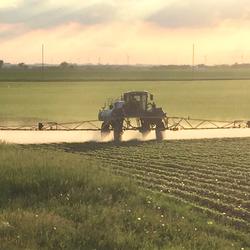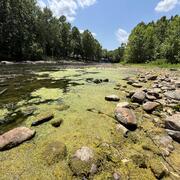Drinking Water
Drinking Water
Filter Total Items: 34
Bioenergy and Pesticides: Lessons from the AltEn Bioenergy Plant
Ethanol production from seed corn, while reducing waste and promoting renewable energy, can have environmental and health implications. A USGS study on a former bioenergy plant that received pesticide-coated seeds used for ethanol production, revealed that the process led to contaminated wastewater and solid residue, resulting in elevated pesticide levels in nearby surface waters even after the...
Leveraging UV Light for Effective Algal Toxin Removal in Drinking Water
Harmful algal blooms (HABs) pose significant risks to public health and the environment by producing dangerous toxins like microcystin-LR (MC-LR), which can exceed safety limits in drinking water. Research by the U.S. Geological Survey, The Ohio State University, and Boise State University evaluated ultraviolet (UV) light treatments for reducing microcystin levels, comparing traditional UV254 with...
Effective Communication in PFAS Research: Moving Beyond "Ubiquitous"
In recent years, per- and polyfluoroalkyl substances (PFAS), have gained attention for their environmental presence; however, the term "ubiquitous" used to describe them can be misleading. USGS scientists push to use more precise language such as "widespread" and “commonly detected” to avoid confusion and misinformation. This distinction is crucial for understanding the actual occurrence of PFAS...
Navigating PFAS Contamination: Insights from the USGS Potomac River Watershed Study
The Potomac River is a major watershed in the eastern United States that serves as a crucial water supply for millions of people. USGS researchers conducted a comprehensive investigation to identify the contributions of municipal and industrial wastewater treatment plant effluent to the levels of per-and polyfluoroalkyl substances (PFAS) in the Potomac River. This study included measuring PFAS...
USGS Environmental Health Program: Integrating Science for Public Health and Resource Management
The USGS Environmental Health Program seeks to understand how environmental factors, especially contaminants and pathogens, influence human health and ecosystems. It focuses on studying the distribution and effects of toxic substances, environmental stressors, and their pathways. The program prioritizes collaboration with State, Federal and local governments; Tribes; non-government organizations...
Algal and Environmental Toxins Research Laboratory — Lawrence, Kansas
About the Laboratory The Environmental Health Program collaborates with scientists at the Organic Geochemistry Research Laboratory (OGRL) in Lawrence, Kansas, to develop and employ targeted and non-targeted analytical methods for identification and quantitation of known and understudied algal/cyanobacterial toxins. The laboratory contructed in 2019 is a 2,500 square foot modern laboratory facility...
Understanding the Dynamics of Per- and Polyfluoroalkyl Substances (PFAS): Insights from USGS Research
The USGS Environmental Health (EH) Program research where per- and polyfluoroalkyl substances PFAS are found, how they move and change in the environment, how they might affect both ecosystems and human health, and ways to reduce their impact. The three teams focusing on these issues within the EH Program include: 1) the PFAS Integrated Science Team, 2) the PFAS Core Technology Team, and 3) the...
Beneath the Surface: Exploring PFAS and Drinking Water on French Island, Wisconsin
The growing concern of finding per- and polyfluoroalkyl substances (PFAS) in drinking water has led USGS scientists to conduct more comprehensive analyses that encompass an extensive list of compounds that can be found in drinking water. These analyses will develop a more complete drinking water contaminant list that managers can use to make more informed public health decisions.
Life Cycle of Critical Minerals: A Balanced Approach to Meeting Our Nation's Resource Demands
Critical minerals are essential to the Nation’s economy and security. Demand for critical minerals is increasing, and it is essential to balance the societal need for these minerals with efforts to understand the effects of mining on other natural resources and to develop techniques to minimize these effects. The USGS Minerals Resources Life Cycle Integrated Science Team (IST) focuses on the life...
By
Ecosystems Mission Area, Geology, Energy, and Minerals Mission Area, Contaminant Biology, Environmental Health Program, Mineral Resources Program, Toxic Substances Hydrology, Columbia Environmental Research Center, Geology, Energy & Minerals Science Center, Geology, Geophysics, and Geochemistry Science Center, Geology, Minerals, Energy, and Geophysics Science Center
Geospatial Analyses and Applications Core Technology Team
About the Research The Geospatial Analyses and Applications Core Technology Team (CTT) as part of the Environmental Health Program collaborates with teams across USGS to develop and apply geospatial analytical methods to answer broad-scale questions about source-sink and cause-effect relationships between contaminants and vulnerable communities.
Drinking Water and Wastewater Infrastructure Science Team
The team studies toxicants and pathogens in water resources from their sources, through watersheds, aquifers, and infrastructure to human and wildlife exposures. That information is used to develop decision tools that protect human and wildlife health.
USGS Scientists Develop an Interactive Mapping Tool to Visualize PFAS in Tap Water
A new interactive dashboard is available to visualize PFAS measurements for 716 tap water samples collected at select sites across the nation between 2016 and 2021 from private and public supplies.













